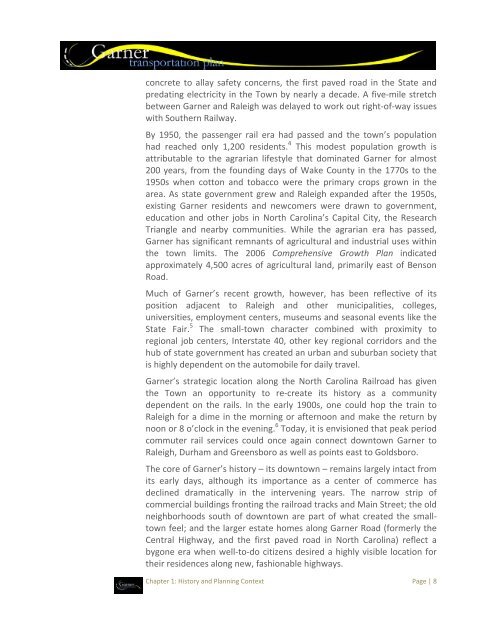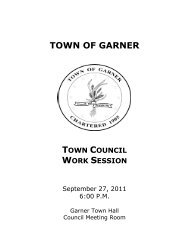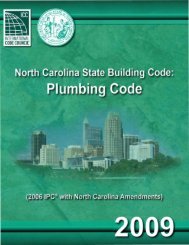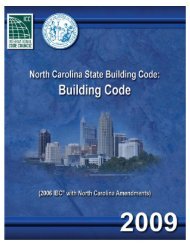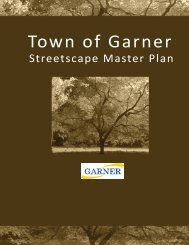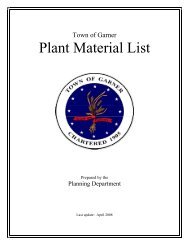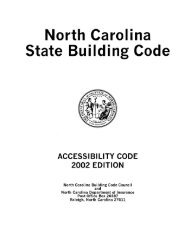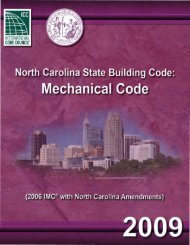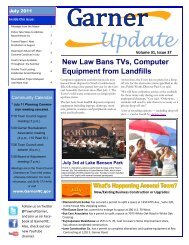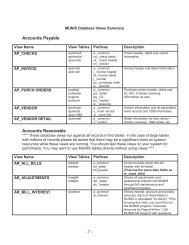Transportation Plan - Town of Garner
Transportation Plan - Town of Garner
Transportation Plan - Town of Garner
Create successful ePaper yourself
Turn your PDF publications into a flip-book with our unique Google optimized e-Paper software.
concrete to allay safety concerns, the first paved road in the State and<br />
predating electricity in the <strong>Town</strong> by nearly a decade. A five‐mile stretch<br />
between <strong>Garner</strong> and Raleigh was delayed to work out right‐<strong>of</strong>‐way issues<br />
with Southern Railway.<br />
By 1950, the passenger rail era had passed and the town’s population<br />
had reached only 1,200 residents. 4 This modest population growth is<br />
attributable to the agrarian lifestyle that dominated <strong>Garner</strong> for almost<br />
200 years, from the founding days <strong>of</strong> Wake County in the 1770s to the<br />
1950s when cotton and tobacco were the primary crops grown in the<br />
area. As state government grew and Raleigh expanded after the 1950s,<br />
existing <strong>Garner</strong> residents and newcomers were drawn to government,<br />
education and other jobs in North Carolina’s Capital City, the Research<br />
Triangle and nearby communities. While the agrarian era has passed,<br />
<strong>Garner</strong> has significant remnants <strong>of</strong> agricultural and industrial uses within<br />
the town limits. The 2006 Comprehensive Growth <strong>Plan</strong> indicated<br />
approximately 4,500 acres <strong>of</strong> agricultural land, primarily east <strong>of</strong> Benson<br />
Road.<br />
Much <strong>of</strong> <strong>Garner</strong>’s recent growth, however, has been reflective <strong>of</strong> its<br />
position adjacent to Raleigh and other municipalities, colleges,<br />
universities, employment centers, museums and seasonal events like the<br />
State Fair. 5 The small‐town character combined with proximity to<br />
regional job centers, Interstate 40, other key regional corridors and the<br />
hub <strong>of</strong> state government has created an urban and suburban society that<br />
is highly dependent on the automobile for daily travel.<br />
<strong>Garner</strong>’s strategic location along the North Carolina Railroad has given<br />
the <strong>Town</strong> an opportunity to re‐create its history as a community<br />
dependent on the rails. In the early 1900s, one could hop the train to<br />
Raleigh for a dime in the morning or afternoon and make the return by<br />
noon or 8 o’clock in the evening. 6 Today, it is envisioned that peak period<br />
commuter rail services could once again connect downtown <strong>Garner</strong> to<br />
Raleigh, Durham and Greensboro as well as points east to Goldsboro.<br />
The core <strong>of</strong> <strong>Garner</strong>’s history – its downtown – remains largely intact from<br />
its early days, although its importance as a center <strong>of</strong> commerce has<br />
declined dramatically in the intervening years. The narrow strip <strong>of</strong><br />
commercial buildings fronting the railroad tracks and Main Street; the old<br />
neighborhoods south <strong>of</strong> downtown are part <strong>of</strong> what created the smalltown<br />
feel; and the larger estate homes along <strong>Garner</strong> Road (formerly the<br />
Central Highway, and the first paved road in North Carolina) reflect a<br />
bygone era when well‐to‐do citizens desired a highly visible location for<br />
their residences along new, fashionable highways.<br />
Chapter 1: History and <strong>Plan</strong>ning Context Page | 8


